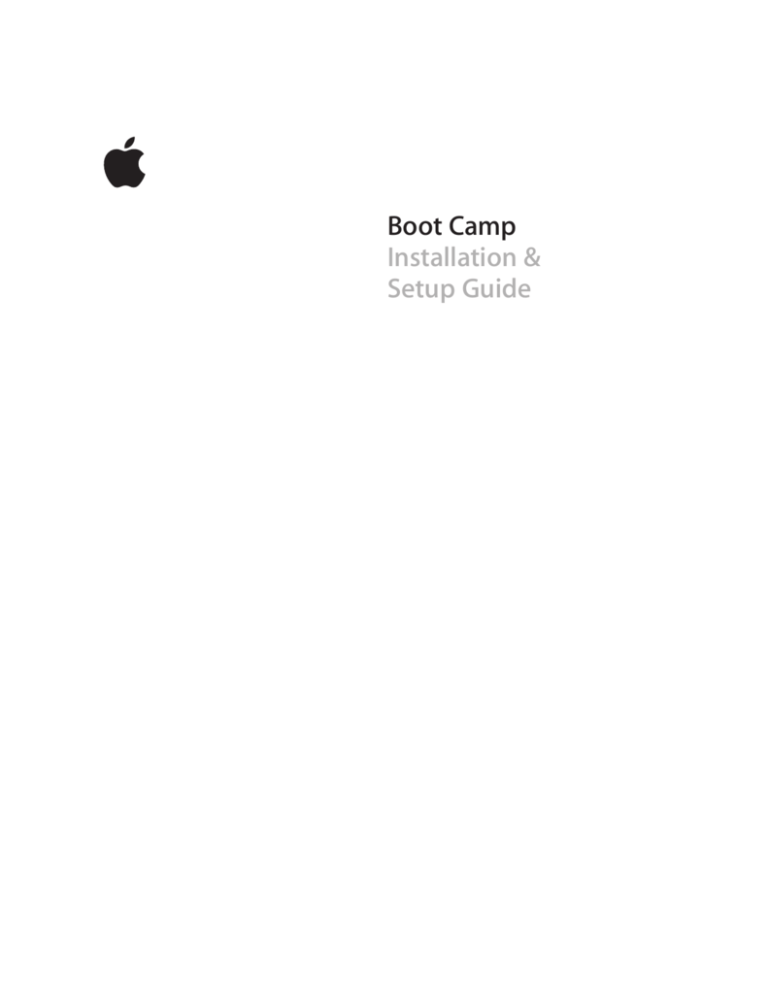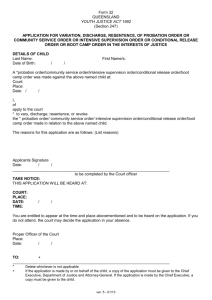
Boot Camp
Installation &
Setup Guide
Contents
4
5
6
6
6
6
6
6
6
6
7
7
8
10
10
10
10
11
11
11
12
12
13
13
13
14
14
14
14
14
15
15
15
2
Introduction
What You Need
Installation Overview
Step 1: Check for updates.
Step 2: Open Boot Camp Assistant.
Step 3: Install Windows.
Step 4: Install the Boot Camp drivers on your Windows volume.
Step 1: Check for updates
Step 2: Open Boot Camp Assistant
Creating a Partition for Windows
If You Have Problems Creating a Partition
Step 3: Install Windows
Selecting and Formatting the Windows Partition
Setting Up Windows
If You Have Problems Installing Windows
If you get a message saying “Installer Disc Not Found” when installing Windows
If the Windows installer isn’t responding
If Windows didn’t install properly
If you insert the wrong disc during installation
Step 4: Install the Boot Camp Drivers for Windows
If You Have Problems Installing the Device Drivers
Starting Up Using Mac OS X or Windows
Setting the Default Operating System
Selecting an Operating System During Startup
If You Have Problems Using Windows on Your Mac
If you see “No Boot Disk Attached” when starting up your computer
If the screen is blank or distorted
If you can’t rename the Windows partition
+H[QWJCXGC4#+&EQP°IWTCVKQP
Removing Windows from Your Computer
Upgrading
Upgrading the Boot Camp Drivers
Upgrading to Windows Vista or Windows 7
17
17
17
If you have problems upgrading Windows
If you see “Windows was unable to create a required installation folder” when
upgrading Windows
Learning More, Support, and Feedback
3
Setting Up Boot Camp
This document shows you how to install and set up
Boot Camp so you can use Microsoft Windows on an
Intel-‐based Mac computer.
Introduction
NOTICE: Make sure to back up all of your data before using Boot Camp, and regularly
back up data while using the software.
Boot Camp lets you install Windows on a Mac computer, using a Microsoft Windows
installation disc that you provide. Windows is installed on its own partition. After
installation, you can use either Windows or Mac OS X on your Mac computer.
The Boot Camp Assistant application helps you create the Windows partition
and restart your Mac using your Windows installation disc. Then you follow these
instructions to install Windows and install software drivers that let Windows work
with your Mac hardware.
If you’ve already installed Windows on your Mac with Boot Camp and you want
to upgrade to Windows Vista or Windows 7, you don’t need to use the Boot Camp
Assistant. Follow the instructions in “Upgrading to Windows Vista or Windows 7”
on page 15.
Important: Before you use Boot Camp Assistant, print this document. It contains
information you’ll need while installing Windows.
4
What You Need
 An Intel-‐based Mac computer with Mac OS X 10.6 or later
 The keyboard and mouse or trackpad that came with your computer. (If they
aren’t available, use a USB keyboard and mouse.)
 Mac OS X version 10.6 or later (the latest version of Mac OS X is strongly
recommended)
 A built-‐in optical disc drive or a compatible external optical drive
For information on using your computer with an external optical drive, see the
documentation that came with your computer.
 A Mac OS X version 10.6 installation disc
 One of the following:
 Windows XP Home Edition or Professional with Service Pack 2 or later (32-‐bit
version only)
 Windows Vista Home Basic, Home Premium, Business, or Ultimate
 Windows 7 Home Premium, Professional, or Ultimate
Important: You must use a single full-‐install Windows installation disc. You cannot use
an upgrade version of Windows. If you’re installing Windows XP, you must use Service
Pack 2 or later. You cannot install an earlier version of Windows XP and then attempt
to update it later.
To see how much free space you need on your disk for Windows, refer to the
documentation that came with Windows.
You can use a 32-‐bit version of Windows XP or Windows Vista with any Intel-‐based
Mac computer. You cannot use a 64-‐bit version of Windows XP on any Mac computer.
You can use a 32-‐bit version of Windows 7 with any of these Mac computers:
 An iMac or MacBook Pro introduced in 2007 or later
 Any Intel-‐based Mac Pro, MacBook, or Mac mini
You can use a 64-‐bit version of Windows Vista or Windows 7 with any of these
Mac computers:
 A Mac Pro or MacBook Pro introduced in early 2008 or later
 An iMac or MacBook introduced in late 2009 or later
If you’re not sure when your Mac computer was introduced, see
http://www.apple.com/support/hardware, click your Mac model, and
look for an article on identifying your Mac.
5
Installation Overview
Installing Windows on your Mac computer involves the following steps:
Step 1: Check for updates.
Step 2: Open Boot Camp Assistant.
Boot Camp Assistant creates a partition for Windows and starts the Windows installer.
Step 3: Install Windows.
Step 4: Install the Boot Camp drivers on your Windows volume.
Important: Before you begin, make sure you have a backup of the important
information on your computer.
Step 1: Check for updates
In Mac OS X, go to http://www.apple.com/support/bootcamp and check whether you
need to update your software before you can install Windows.
Step 2: Open Boot Camp Assistant
Boot Camp Assistant helps you create a new partition for Windows and gets you
started with the Windows installation.
Important: If you’re using a portable computer, connect the power adapter before
continuing.
To use Boot Camp Assistant:
1 Log in to an administrator account on your computer, quit all open applications, and
log out any other users on your computer.
2 %JQQUG#RRNG
Ñ 5QHVYCTG7RFCVG
Install all available updates. If your computer restarts after installing an update, choose
#RRNG
Ñ 5QHVYCTG7RFCVGCICKPVQKPUVCNNCP[CFFKVKQPCNWRFCVGU
3 Open Boot Camp Assistant (in the Utilities folder in the Applications folder).
Creating a Partition for Windows
Boot Camp Assistant lets you choose the size for your Windows partition, and then
creates that partition on your internal disk drive without erasing any data.
Note: If your computer has more than one internal disk and you want to install
$QQV%CORQPCFKUMVJCVKUP¨VKPVJG°TUVJCTFFTKXGDC[TGOQXGVJGFTKXGUKPVJG
lower numbered bays. You can reinstall the drives after you install Boot Camp.
6
Refer to your Windows installer documentation to help you determine the best
partition size for your system. Windows Vista and Windows 7 require more disk
space than Windows XP.
If you’re installing Windows XP and your Windows partition can be 32 GB or smaller,
you can choose between two formats for that partition. You’ll select the format in
a later step, but you must decide on a format now so you can choose an appropriate
size. Here are the two formats:
 06(5¤2TQXKFGUDGVVGTTGNKCDKNKV[CPFUGEWTKV[DWV[QWYKNNPQVDGCDNGVQUCXG°NGU
to the Windows volume from Mac OS X. This partition can be any size.
 (#6¤2TQXKFGUDGVVGTEQORCVKDKNKV[CNNQYKPI[QWVQTGCFCPFYTKVG°NGUQPVJG
Windows volume from Mac OS X. This partition must be 32 GB or smaller.
If you’re installing Windows Vista or Windows 7, the Windows partition must use the
NTFS format.
If You Have Problems Creating a Partition
If you have problems creating a Windows partition, check the following:
 The disk must be a single partition, formatted as Mac OS Extended (Journaled).
If the disk already has more than one partition, you must repartition it.
 The disk must be an internal disk. You cannot use Boot Camp Assistant to install
Windows on an external disk.
 +HCFKCNQICRRGCTUUC[KPI¥6JGFKUMECPPQVDGRCTVKVKQPGFDGECWUGXGTK°ECVKQP
failed,” try repairing the disk using Disk Utility and opening Boot Camp Assistant
again. If that doesn’t work, back up all the information on your computer, start up
from your Mac OS X installation disc, and erase the disk using Disk Utility. Restore
the information to your computer from the backup and try opening Boot Camp
Assistant again.
Step 3: Install Windows
Read and follow these instructions for installing Windows on your Mac computer.
Refer to your Windows documentation for general information about installing and
setting up Windows.
To install Windows on your Mac computer:
1 If you already quit Boot Camp Assistant without installing Windows:
a Open Boot Camp Assistant.
b Select “Start the Windows installer.”
c Click Continue.
2 Insert your Windows installation disc.
7
3 In Boot Camp Assistant, click Start Installation.
Your computer starts up from the Windows installation disc.
4 Follow the onscreen instructions. Refer to the following sections for more information.
If you're asked to choose between an upgrade or custom installation, choose a custom
installation.
Selecting and Formatting the Windows Partition
It’s important to select the correct partition when installing Windows so that you don’t
overwrite Mac OS X on your computer. You’ll then choose the correct format.
NOTICE: Do not create or delete a partition, or select any partition other than as
noted below. Doing so may delete the entire contents of your Mac OS X partition.
To select and format the correct partition for Windows Vista or Windows 7:
1 Select “Disk 0 Partition 3 BOOTCAMP.”
2 Click “Drive options (advanced).”
8
3 Click Format, and then click OK.
4 Click Next.
6JG9KPFQYURCTVKVKQPKUHQTOCVVGFWUKPIVJG06(5°NGU[UVGO
To select and format the correct partition for Windows XP:
1 5GNGEV¥%2CTVKVKQP$116%#/2 =(#6?¦
9
2 Select an NTFS or FAT format:
 06(5¤2TQXKFGUDGVVGTTGNKCDKNKV[CPFUGEWTKV[DWV[QWYKNNPQVDGCDNGVQUCXG°NGU
to the Windows volume from Mac OS X.
 (#6¤2TQXKFGUDGVVGTEQORCVKDKNKV[CNNQYKPI[QWVQTGCFCPFYTKVG°NGUQPVJG
Windows volume from Mac OS X. This option is available only if the Windows
partition is 32 GB or smaller.
Important: &QPQVUGNGEV¥.GCXGVJGEWTTGPV°NGU[UVGOKPVCEV¦6QUWEEGUUHWNN[KPUVCNN
Windows XP, you must select one of the other options.
Setting Up Windows
After you install the Windows software, your computer automatically restarts using
9KPFQYU7UGVJG9KPFQYUUGVWRUETGGPUVQEQP°IWTG9KPFQYU
If You Have Problems Installing Windows
If you have problems installing Windows, try the following solutions.
If you get a message saying “Installer Disc Not Found” when installing Windows
Make sure you’re logged in to Mac OS X as an administrator.
If the Windows installer isn’t responding
Be sure you are using the original keyboard and mouse that came with your computer.
If you’re using an Apple mouse, the Windows installer may not respond if the mouse
is connected directly to your computer. Connect the mouse to the USB port on your
keyboard.
10
If Windows didn’t install properly
Verify that you’re using an original, full version of one of the following:
 Windows XP Home Edition or Professional with Service Pack 2 or later
 Windows Vista Home Basic, Home Premium, Business, or Ultimate
 Windows 7 Home Premium, Professional, or Ultimate
Media Center, OEM, and upgrade versions of Windows XP are not recommended.
Restart your computer and hold down the Option key until one or more disk icons
appears on your screen. Insert the Windows installation disc. Select the Windows
installation disc icon and then click the arrow beneath it. Quickly press any key on
your keyboard to start the installer. Follow the onscreen instructions to repair or
reinstall Windows.
If you insert the wrong disc during installation
Eject the disc by holding down the Eject key on your keyboard while restarting
the computer.
Step 4: Install the Boot Camp Drivers for Windows
#HVGTKPUVCNNKPI9KPFQYUKPUVCNN/CEURGEK°EFTKXGTUCPFQVJGTUQHVYCTGHQT
Windows using your Mac OS X installation disc.
The Mac OS X disc installs drivers to support Mac components, including AirPort,
built-‐in iSight camera, the Apple Remote, the trackpad on a portable Mac, and the
function keys on an Apple keyboard.
The Mac OS X disc also installs the Boot Camp control panel for Windows and the
Apple Boot Camp system tray item.
To install the Boot Camp drivers:
1 Eject the Windows installation disc.
2 Insert the Mac OS X disc.
If the installer doesn’t start automatically, browse the disc using Windows Explorer
CPFFQWDNGENKEMVJGUGVWRGZG°NGKPVJG$QQV%CORFKTGEVQT[
3 Follow the onscreen instructions.
If a message appears that says the software you’re installing has not passed Windows
Logo testing, click Continue Anyway.
9KPFQYUVJCVCRRGCTQPN[DTKG±[FWTKPIVJGKPUVCNNCVKQPFQP¨VTGSWKTG[QWTKPRWV
11
If nothing appears to be happening, there may be a hidden window that you must
respond to. Check the taskbar and look behind open windows.
Important: Do not click the Cancel button in any of the installer dialogs.
4 After your computer restarts, follow the instructions in the Found New Hardware
Wizard to update your software drivers (Windows XP only).
5 Follow the instructions for any other wizards that appear.
6 Check for updated Boot Camp drivers by using Apple Software Update or going to
www.apple.com/support/bootcamp.
If You Have Problems Installing the Device Drivers
If it appears that the Boot Camp drivers weren’t successfully installed, try
repairing them.
To repair Boot Camp drivers:
1 Start up your computer in Windows.
2 Insert your Mac OS X installation disc.
3 If the installer doesn’t start automatically, browse the disc using Windows Explorer
CPFFQWDNGENKEMVJGUGVWRGZG°NGKPVJG$QQV%CORFKTGEVQT[
4 Click Repair and follow the onscreen instructions.
If a message appears that says the software you’re installing has not passed Windows
Logo testing, click Continue Anyway.
+H[QWPGGFVQTGKPUVCNNURGEK°EFTKXGTU[QWECPKPUVCNNQPGFTKXGTCVCVKOG(QTGZCORNG
if your built-‐in iSight camera isn’t working, you can reinstall just the iSight driver.
Individual drivers are in the Drivers folder on the Mac OS X installation disc.
6QTGKPUVCNNCURGEK°EFTKXGT
1 Insert your Mac OS X installation disc.
2 Quit AutoRun if it opens.
3 Using Windows Explorer, locate the driver that you want to reinstall.
4 Open the driver to start the installation.
Starting Up Using Mac OS X or Windows
After you’ve installed Windows and the Boot Camp drivers, you can start using
Windows on your Mac. Boot Camp makes it easy to start up your computer using
either Mac OS X or Windows. You can set the default operating system for your
computer using Startup Disk preferences (Mac OS X) or the Boot Camp control panel
(Windows). You can also select an operating system as your computer is starting up.
12
Setting the Default Operating System
You can use the Startup Disk pane of System Preferences in Mac OS X to set the
default operating system for starting up your computer. Boot Camp also installs a Boot
Camp control panel that lets you set the default operating system when you’re using
Windows.
To set the default operating system in Mac OS X:
1 +P/CE15:EJQQUG#RRNGOGPW 5[UVGO2TGHGTGPEGUCPFVJGPENKEM5VCTVWR&KUM
2 Select the startup disk with the operating system you want to use by default.
3 If you want to start up that operating system now, click Restart.
To set the default operating system in Windows:
1 In Windows, click the Boot Camp icon in the system tray and choose Boot Camp
Control Panel.
Note: ;QWTUETGGPOC[NQQMFKÒGTGPVFGRGPFKPIQPYJKEJEQORWVGT[QW¨TGWUKPI
2 Select the startup disk with the operating system you want to use by default.
3 If you want to start up that operating system now, click Restart.
To restart in Mac OS X using the Boot Camp icon in the system tray:
m In Windows, click the Boot Camp icon in the system tray and choose “Restart in
Mac OS X."
This also sets the default operating system to Mac OS X.
Selecting an Operating System During Startup
You can select which operating system to use during startup by holding down the
Option key. This displays icons for all available startup disks, and lets you override the
default setting for the startup disk in Startup Disk preferences (Mac OS X) or the Boot
Camp control panel (Windows) without changing that setting.
To select an operating system during startup:
1 Restart your computer and hold down the Option key until disk icons appear
onscreen.
2 Select the startup disk with the operating system you want to use, and then click the
arrow beneath the icon.
If You Have Problems Using Windows on Your Mac
If you’re having trouble using Windows on your Mac, try the solutions below.
For more troubleshooting information, go to www.apple.com/support/bootcamp.
13
If you see “No Boot Disk Attached” when starting up your computer
You may have formatted your Boot Camp partition incorrectly so it cannot start up
your computer. Start up your computer with Mac OS X and open Boot Camp Setup
Assistant. Remove the Boot Camp partition and then re-‐create it. Install Windows
again, being sure to format the partition.
If the screen is blank or distorted
Some graphics cards may not work with both Mac OS X and Windows on a Mac
computer. If you’re having trouble with your screen display when using Windows, try
the following:
 Use the graphics card that came with your Mac.
 Make sure you’ve installed the Boot Camp drivers. See “Step 4: Install the Boot Camp
Drivers for Windows” on page 11.
 Adjust the screen resolution setting in the Display control panel.
 Go to http://www.apple.com/support/bootcamp and check for compatibility
information and updated software for your computer.
If you can’t rename the Windows partition
You can rename the Windows partition only in Windows. Start up in Windows and
right-‐click the C: drive in Windows Explorer. Then type a name.
+H[QWJCXGC4#+&EQP°IWTCVKQP
4#+&EQP°IWTCVKQPUWUKPI$QQV%CORCTGPQVUWRRQTVGF(QTOQTGKPHQTOCVKQPIQVQ
www.apple.com/support/bootcamp and search for “RAID.”
Removing Windows from Your Computer
How you remove Windows from your computer depends on whether you installed
Windows on a single-‐volume disk or on a second disk partition.
If you installed Windows on a second disk partition: Using Boot Camp Assistant as
described below, remove Windows by deleting the Windows partition and restoring
the disk to a single-‐partition Mac OS X volume.
If your computer has multiple disks and you installed Windows on a disk that has only
one partition: Start up in Mac OS X and use Disk Utility, in the Utilities folder in the
Applications folder, to reformat it as a Mac OS X volume.
To delete Windows and the Windows partition:
1 Start up in Mac OS X.
2 Quit all open applications and log out any other users on your computer.
3 Open Boot Camp Assistant.
4 Select “Create or remove a Windows partition,” and then click Continue.
14
5 Do one of the following:
 If your computer has a single internal disk, click Restore.
 If your computer has multiple internal disks, select the disk with Windows on it,
and then select “Restore to a single Mac OS partition” and click Continue.
Upgrading
These sections describe how to upgrade Windows or your version of Boot Camp.
Upgrading the Boot Camp Drivers
If you’ve already installed Windows on this computer, you can install the updated
Mac drivers for Windows.
Important: If you’ve customized your Windows environment, write down your settings
before updating the drivers.
To update the Boot Camp drivers for Windows:
1 Restart your Mac using Windows.
2 Click the Boot Camp icon in the system tray and choose About Boot Camp.
3 If the version is 3.0 or later, use Apple Software Update to check for updated drivers.
4 If the version is earlier than 3.0, insert your Mac OS X version 10.6 installation disc.
When the installer starts, click Repair.
If the installer doesn’t start automatically, browse the disc using Windows Explorer and
FQWDNGENKEMVJGUGVWRGZG°NGKPVJG$QQV%CORFKTGEVQT[
Upgrading to Windows Vista or Windows 7
You can upgrade Windows XP to Windows Vista or Windows Vista to Windows 7.
Note: If you’re using Windows XP, you cannot upgrade to Windows 7. You can perform
a clean install (also called a custom install), which erases your Boot Camp partition.
Before you perform a clean install, make sure you have the installation discs for all your
RTQITCOUCPFCDCEMWRQH[QWTRGTUQPCN°NGUCPFUGVVKPIU;QWECPTGUVQTGVJGOCHVGT
the installation.
To upgrade from Windows Vista to Windows 7
To upgrade to Windows 7, you need:
 Windows Vista installed on your Boot Camp partition
 A licensed copy of Windows 7 Home Premium, Professional, or Ultimate
 Apple_WIn7_Upgrade_Utility.exe, which is available at http://www.apple.com/
support/bootcamp. The Windows 7 installer may not be able to install Windows 7 if
your Mac OS X partition is mounted. This utility unmounts your Mac OS X partition.
It will be mounted again when you download updated software for Windows 7.
15
1 In Mac OS X, go to http://www.apple.com/support/bootcamp and check whether
you need to update your software before you can upgrade to Windows 7. Some
/CEEQORWVGTUTGSWKTGURGEK°EWRFCVGUDGHQTG[QWECPKPUVCNN9KPFQYU
2 Start up your Mac in Windows.
3 Use Apple Software Update to check for updated drivers for Windows Vista.
4 Go to the website http://www.apple.com/support/bootcamp, and download
Apple_WIn7_Upgrade_Utility.exe.
5 Open AppleWin7Utility.exe, and follow the onscreen instructions.
Apple_WIn7_Upgrade_Utility.exe unmounts your Mac OS X partition.
6 Insert your Windows 7 installation or upgrade disc.
7 Follow the instructions that came with Windows 7.
8 After your computer starts up in Windows 7, use Apple Software Update to check
for updated software for Windows 7. Your Mac OS X partition is mounted again.
To upgrade from Windows XP to Windows Vista
To upgrade to Windows Vista, you need:
 Windows XP installed on your Boot Camp partition
 A licensed copy of Windows Vista Home Basic, Home Premium, Business, or Ultimate.
1 In Mac OS X, go to http://www.apple.com/support/bootcamp and check whether
you need to update your software before you can upgrade to Windows Vista.
5QOG/CEEQORWVGTUTGSWKTGURGEK°EWRFCVGUDGHQTG[QWECPKPUVCNN9KPFQYU8KUVC
2 Start up your Mac in Windows.
3 Insert your Windows Vista installation or upgrade disc.
4 Follow the instructions that came with Windows Vista.
5 After completing the installation, insert your Mac OS X installation disc.
If the installer doesn’t start automatically, browse the disc using Windows Explorer and
FQWDNGENKEMVJGUGVWRGZG°NGKPVJG$QQV%CORFKTGEVQT[
6 Check for updated Boot Camp drivers by using Apple Software Update or going to
http://www.apple.com/support/bootcamp.
To perform a clean install
1 In Mac OS X, go to http://www.apple.com/support/bootcamp and check whether you
need to update your software before you can upgrade Windows.
2 Start up your Mac in Windows.
3 Back up your personal data, and make sure you have the installation discs for any
applications you use.
4 Insert your Windows installation or upgrade disc.
16
5 Follow the instructions that came with Windows Vista or Windows 7.
6 After completing the installation, insert your Mac OS X installation disc.
If the installer doesn’t start automatically, browse the disc using Windows Explorer and
FQWDNGENKEMVJGUGVWRGZG°NGKPVJG$QQV%CORFKTGEVQT[
7 Check for updated Boot Camp drivers by using Apple Software Update or going to
http://www.apple.com/support/bootcamp.
8 Restore your personal data and applications.
If you have problems upgrading Windows
If you’re having trouble upgrading Windows on your Mac, try the solution below.
For more troubleshooting information, go to www.apple.com/support/bootcamp.
If you see “Windows was unable to create a required installation folder” when
upgrading Windows
You may see this alert if you install Boot Camp 3.0 or later and then try to upgrade
to Windows 7. Before you update to Windows 7, download Apple_WIn7_Upgrade_
Utility.exe, which is available at http://www.apple.com/support/bootcamp. For more
information, see “Upgrading to Windows Vista or Windows 7” on page 15.
Learning More, Support, and Feedback
For more information about Boot Camp, go to www.apple.com/bootcamp.
For Boot Camp support, go to www.apple.com/support/bootcamp.
Apple welcomes your feedback on Boot Camp. To submit feedback, go to
www.apple.com/macosx/feedback.
Apple does not provide support for installing or using Microsoft Windows software.
6Q°PFJGNRHQT9KPFQYUKUUWGUIQVQYYYOKETQUQHVEQOYKPFQYU
17
© 2010 Apple Inc. All rights reserved.
Apple, the Apple logo, AirPort, Boot Camp, iMac, iSight, Mac, MacBook, and Mac OS are trademarks
of Apple Inc., registered in the U.S. and other countries. Intel, Intel Core, and Xeon are trademarks
of Intel Corp. in the U.S. and other countries. Other company and product names mentioned
herein may be trademarks of their respective companies.
019-‐1702 2010-‐1








